
Whether it’s chlorine, pH balancers, algaecides, or other essential pool chemicals, understanding their longevity is vital for ensuring optimal effectiveness. Over time, exposure to factors like temperature, moisture, and sunlight can impact the stability and potency of these chemicals, potentially compromising their ability to keep your pool water clean and safe.
In today’s article, we talk about chlorine shelf life and answer the age-old question of, “Do pool chemicals expire, or do they lose efficacy over time?”
Shelf Life of Pool Chemicals
Liquid Chlorine

Sodium Hypochlorite, or chlorine bleach, is a comparatively unstable form of chlorine, in that it can lose up to 50% potency within the first 6 months, and 90% within one year. If subjected to hot or cold temperatures or direct sunlight, degradation occurs more quickly. For a more stable product, see our Instant Liquid Chlorine in a bottle.
Tablet Chlorine

Trichlor tablets have the longest chlorine shelf life. We have lab tested our individually wrapped tablets for potency over time. At 36 months, In The Swim tablets still have 98% of their original available chlorine, when stored in constant 50-70° F temps with a tightly closed bucket lid. In the right conditions, trichlor tablets can remain viable for more than 5 years.
Granular Chlorine
Calcium Hypochlorite, aka pool shock or granular chlorine, also has a long shelf life, if kept in an air tight container, in a cool and dry (indoor) location. Pool shock in 1 lb. bags absorb moisture from humid air, and bags can dissolve in 12-24 months. For longer term storage, re-pack into freezer bags or buy Chlorine Granules, sold in buckets. Properly stored, pool shock has a shelf life of more than 5 years.
Stabilizer
Cyanuric acid, or chlorine stabilizer, will maintain potency indefinitely, even if it absorbs moisture, as long as it is stored in a tightly closed container. Be sure to label cyanuric acid as Conditioner or Stabilizer, so the white powder won’t be confused with another chemical should the container label fade or become unreadable.
Algaecides
When properly stored (cool and dry indoor location), pool algaecides are quite stable and most will maintain potency for up to 5 years. Temperatures over 75° F and direct sunlight will reduce algaecide shelf life, especially lower concentration algaecides (10% and 30% formulations). However, freezing temperatures can ruin pool algaecide.
Clarifiers
Similar to algaecides, pool clarifiers have a shelf life of up to 5 years, stored tightly closed in consistently cool temperatures, in a dark cabinet or container. Outdoor storage in a garage or shed with high temperatures can reduce effectiveness, and freezing can damage the polyamide structure, rendering clarifiers useless.
Stain & Scale
Most Stain & Scale chemicals, such as Stain Away, have an indefinite shelf life, with the usual caveat – when closed tightly and stored in a cool, dry location (indoors). As with other liquid pool chemicals sold in bottles, the formulations are very stable, but high and low temperatures should be avoided to maintain product strength.
Alkalinity & Calcium Increaser
Sodium Bicarbonate and Calcium Carbonate are both dry white powder or flake chemicals, and both can remain viable and potent for more than 5 years. As with other dry pool chemicals, shelf life can be extended with tightly closed lids to keep out moisture, which can cause clumping and hardening of your water balance chemicals.
pH Increaser
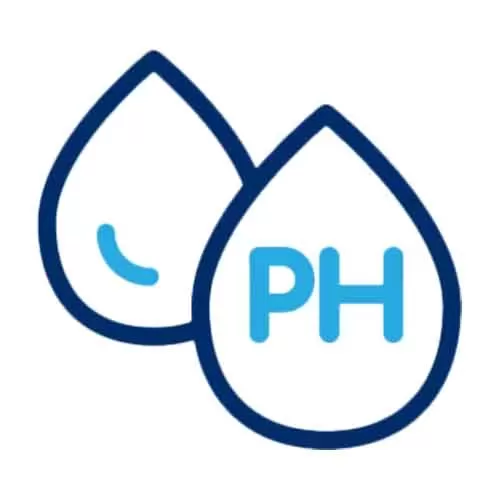
Sodium carbonate or soda ash (pH Increaser) can remain viable for more than 5 years, when stored in an air-tight container, to lock out moisture. If stored outdoors, humid conditions can pull moisture into the bucket, clumping and hardening, but also converting sodium carbonate to sodium bicarbonate over time, slightly reducing the effect on pH.
pH Decreaser
Sodium Bisulfate and muriatic acid could have a 5 year shelf life; however pH decreasers are acids, and a larger shelf life concern about pH decreasers is the strength of the container. Over time, thin plastic bottles or packaging can break down from contact with acids. So, although pH-Down chemicals last for years, you should probably use them up.
So, what have we learned today?
Most pool chemicals have a shelf life of 3-5 years, when stored properly:
- Consistent and cool temperatures, in a dry and dark location.
- Tight bucket lids and bottle caps, and sealed inner bags to lock out moisture and contaminants.
- Granular Chlorine can dissolve packaging, repack for long-term storage.
- Keep all pool chemicals out of reach of children.

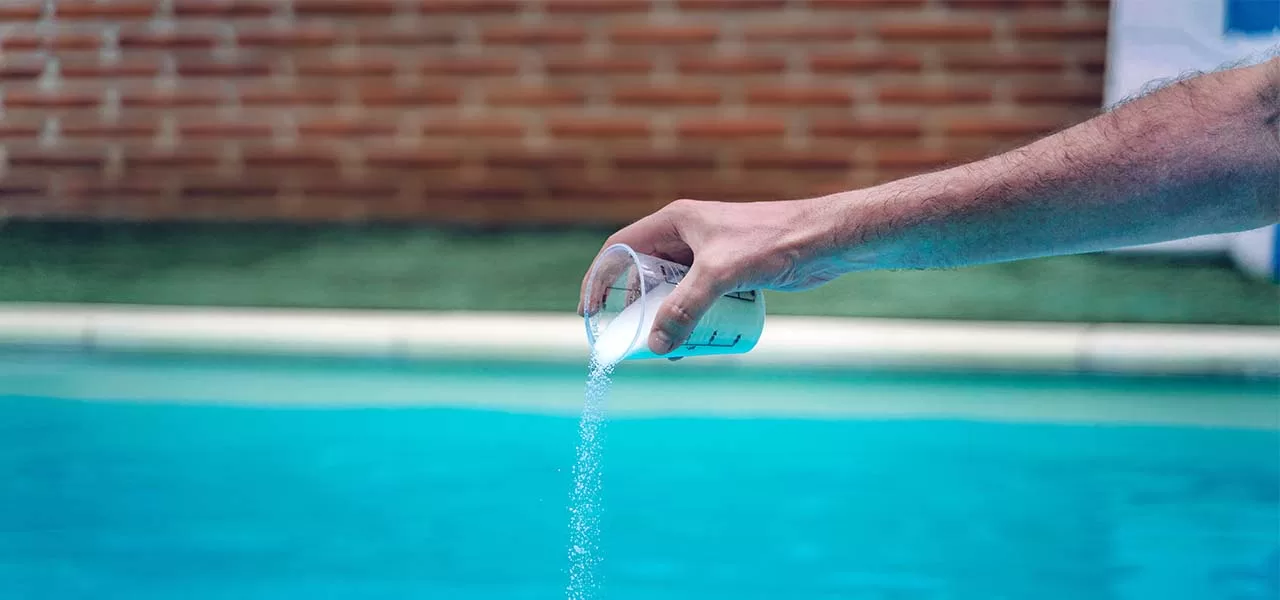
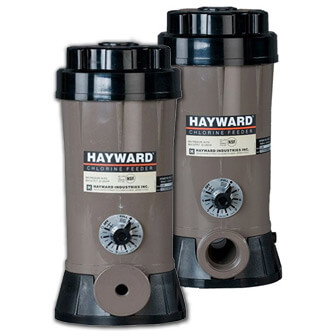




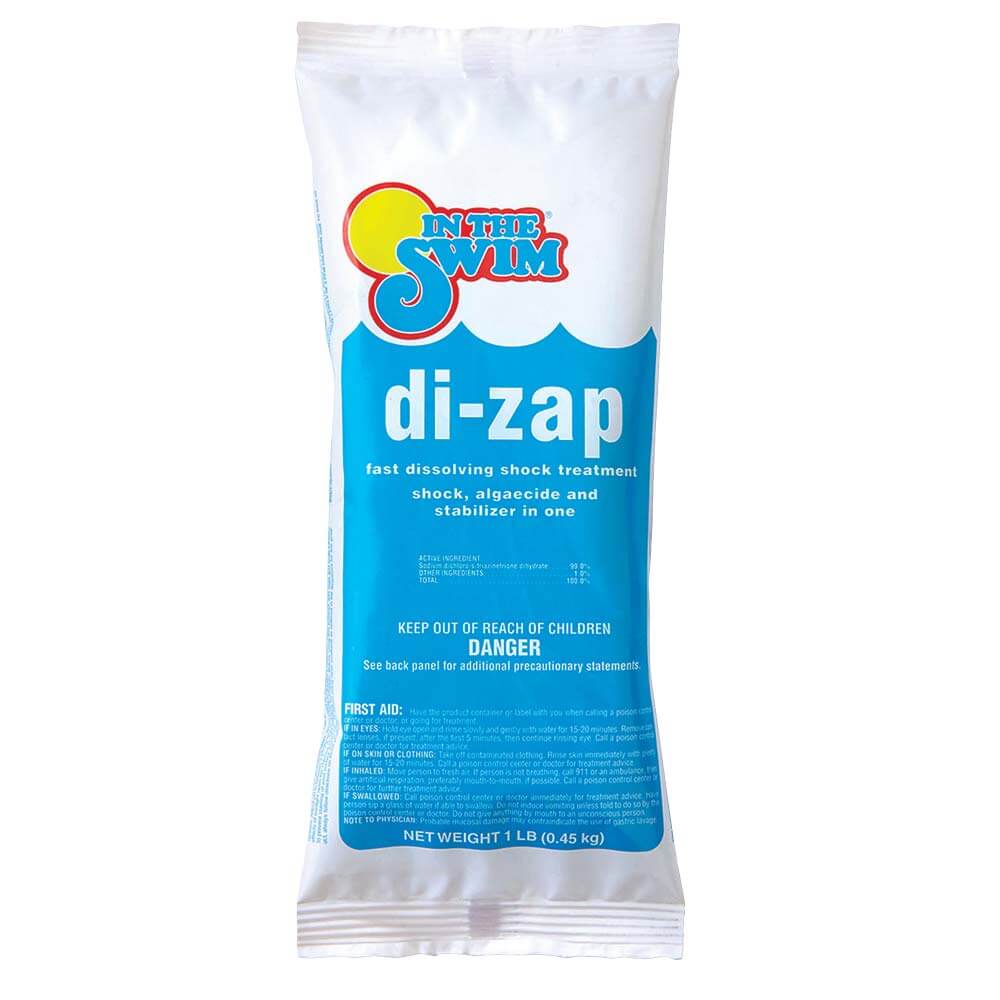
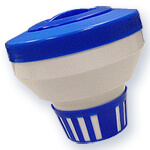

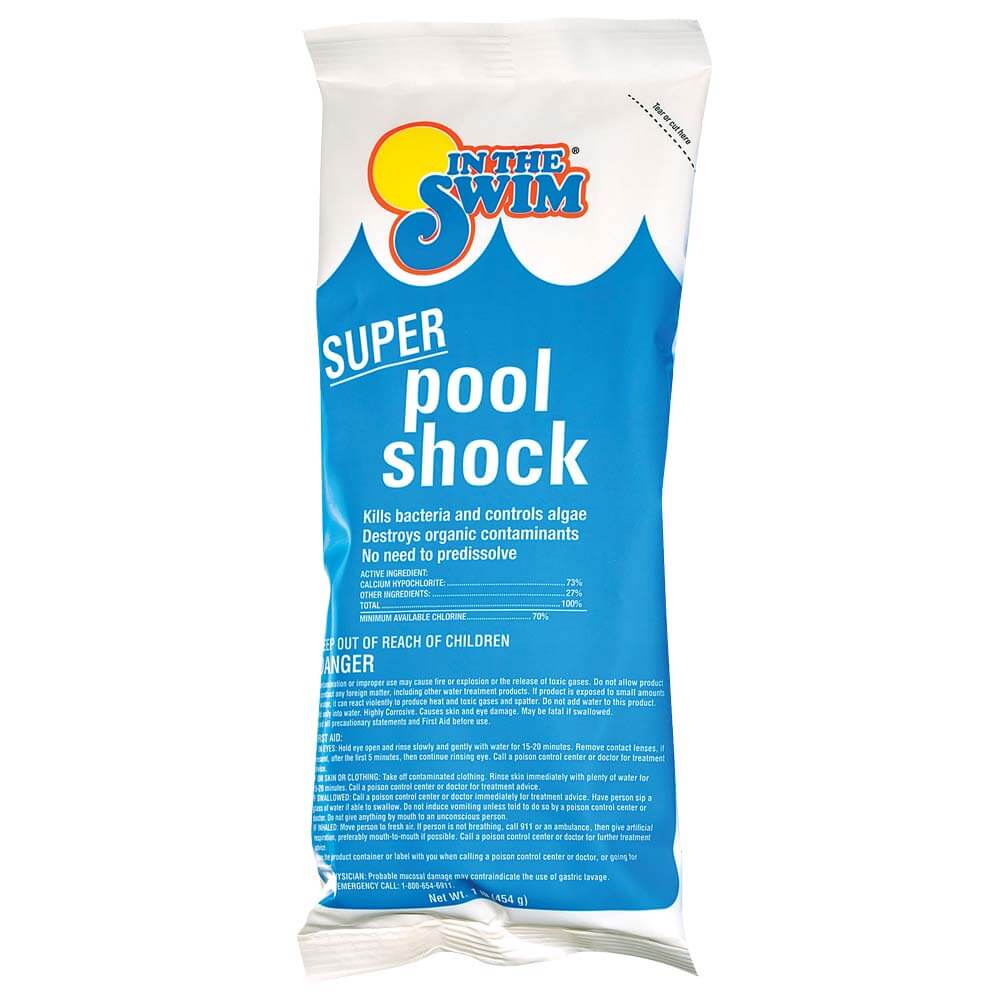

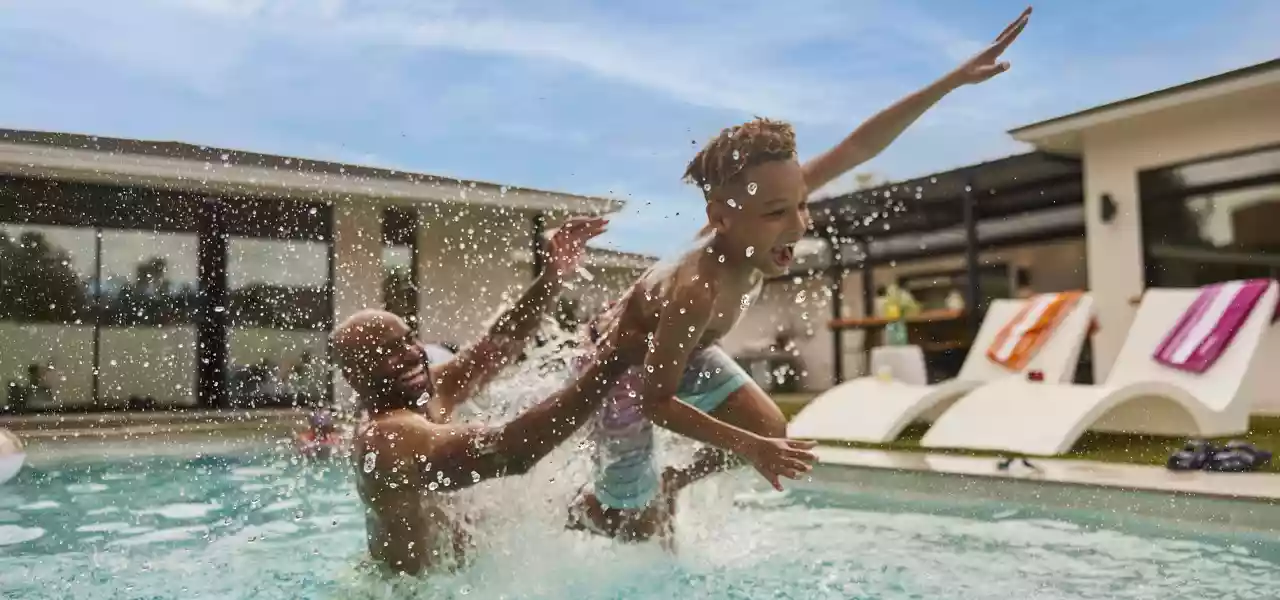
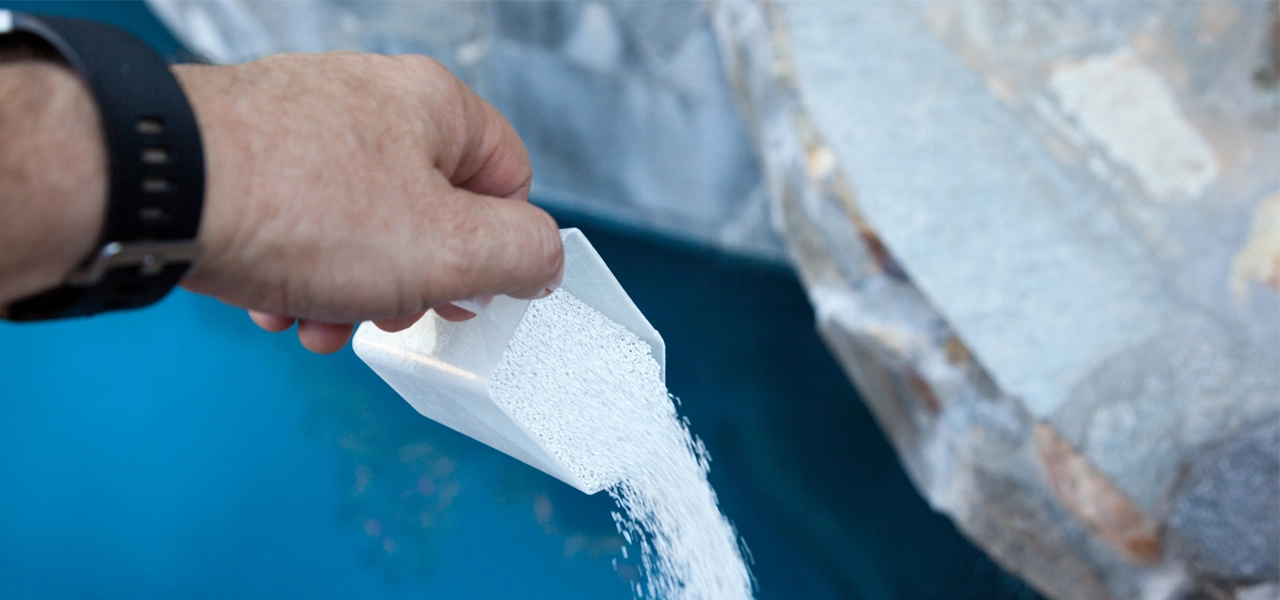
My father in law got sick this year and was unable to care for his pool, so I’ve been trying to help. He has a bucket of intheswim 3” wrapped chlorine tabs that has been left out in the 90 degree heat and in direct sunlight this summer. I opened it to put tabs in the pool and there was a yellow haze in the bucket that dispersed once the lid was opened. Are these tabs still good or should I dispose of them and buy new?
Hi Milt, should still be good. The yellow haze is a chlorine gas, so be careful not to breathe it… Tabs are best stored in a cool, dry location, but not indoors, and not near metal equipment, which can rust from the chlorine gas, which can sometimes leak small amounts of gas, even if the lid is replaced very tightly each time.
I have some granular chlorine that has turned liquidy. Lid must not have gotten put back on tight. Can I still use it?
Yes, and use it as fast as you can, before it loses more potency.
Hi. My chlorine granules are having no effect on raising the level of chlorine in the pool. The pH levels are ok. Maybe it has gone off? It is a new bottle of granules but has been stored outside and gets hot in the sun. It is in the shade but the storage box it is in still gets quite hot. When I open the bottle there is a strong has smell. Could they have gone off in the heat? Thanks.
Hi David, heat is one of those things that can drain the potency from shock. I’ll be the label says “…store in a cool, dry location” somewhere on there. I’d try it again, or try a teaspoon in a glass of water, and then drop a few drops of test reagent. One could also consider that your test reagents or strips are bad, but it’s probably the shock, weakened from the sun.
Where can I find the best before date on a bottle of chlorine graduals? We’ve just got a new spa, we uogreded and I feel the chemicals may be out of date. We have only had it 2 weeks and have cha her water twice as all keep coming out in spots after we use it. I make sure levels are correct before and after use and we shower before and after use but this isn’t stopping the spots, also it’s not holding the chlorine levels or free chlorine for more then 24hrs and this is without use. I feel chlorine may be off and not working properly. Help!
Hi Louise, chlorine does have a shelf-life, and will lose potency over time, but normally can last for several years, when tightly closed. I’m not sure where the best used by date would be, or if it even exists – it may be written in ‘code’, so that only the manufacturer can tell you. Not holding chlorine for longer than 24-hours may indicate that there are levels of contaminants higher than the level of chlorine can remove, but you are correct it could also indicate a loss of potency in the chlorine.
Please tell me Self life of technical urea,formaldehyde 37%,Melamine powder, Phenol 94%,. Sodium penta choro fenate granular & Rhodamine dye.
I have a half bag of calcium flakes that are about a year old. They have seeped out fluid and it is now a big clump. Can I break it up and dissolve the pieces to use in the pool? Thanks!
Hi Kim, yes you can still use it, no need to break it up, it will dissolve in the bucket, then just pour it in the pool.
my two buckets of Chlorinating Granules have been is a shed over one or two winters, the granules have a slight green tint and firm but easily broken back to singular granules. Does this still have potency or is it ruined, I can still smell chlorine.
Hi Mark, yes still potent, may have lost 10% of so, but should still work to disinfect and sanitize.
I have several bags of In the Swim powdered shock that I bought probably around 5 years ago.
I’m guessing there is no way to know if it’s expired without using it, but would like to know if there is.
Also, if I do use it, and it is expired, can it do harm to my water balance and/or pool lining, or will it just not be effective?
Thanks in advance for your help.
Harry
Hi Harry, the best thing is to use it, the shock still has some potency, but perhaps 20-40% less than when new. No harm in using it. Thanks, good question.
my granular sani chlor was left outside at 20 degrees for 2 nights. is it ruined?
Hi Celeste – no, I don’t think so, low temperatures should not effect shock chlorine for a few nights. It won’t freeze, so as long as the package was tightly closed, it should still be potent and viable.
I keep my pool shock in the original child proof container, indoors. Last night i set it down outside and forgot to bring it in until this morning. Should I be concerned about moisture? it was only about 60 degrees last night. Im not noticing a strong smell or anything.
Hi, no worries! Just keep the lid on tight, that will keep out most moisture, and at those temps, no worries about condensation.
I had a bottle of 57.something% hth Calcium hypochlorite and 48 % other stuff. The bottle cracked but nothing spilled.The plastic seems deteriorated and the print is crumbling. Is the stuff of any use? It probably absorbed moisture, but I’m in a low humidity environment, but it was in the kitchen so when I boil things a lot of moisture in the air, you can see it condensing on the windows. What do I do with this stuff? It’s from 4 to 9 years old. Not sure. Thanks.
Hi Bob, if you have a pool, pout the contents into a 5-gal bucket that has been pre-filled with water. Stir to dissolve and pour into the pool. Less potency than when new, but still has some sanitizing effect. You could also use it as a bleaching solution, for laundry or cleaning tasks.
so what should I do with a large amount of expired chlorine and algaecide?
Hi John, excellent question! Your local landfill can give you more information, they may have a special day or special facility where you can deliver it and drop it off, hopefully free..? You could also use it in a pool, or give it to somebody that wouldn’t mind that it’s expired. Unless you cannot read the label any longer, then it could be unsafe, or if it is not safe for transport. But if so, maybe an ad on craigslist Free Pool Chemicals! 🙂 That word Free is a powerful motivator…
Hi what is the difference between the CL100 and CL200 chlorine feeders.The CL100 states that it’s for an above ground pool the only difference I read that the CL100 has a capacity of 4lbs of tablets,and the CL200 has 9lbs. The reason I ask is because I installed the CL200 in line feeder for my above-ground pool and after installation I removed top cover of feeder and water keeps pouring out the top,so I’m wondering if the CL100 has some kind of internal check valves that prevent water from overflowing. All the youtube videos show that after turning pump off you remove lid theres no water pouring out,which makes sense because they are all inground pools and the feeder is higher than water level. So do I need to install the CL100 because I have an above ground pool?
Hi, the only difference is size, there is no check valve or any other difference between CL100 and CL200. You could install a cheap ($15) valve on the line, or push a plug into the return line, to slow the water flow, and keep your socks dry, lol.